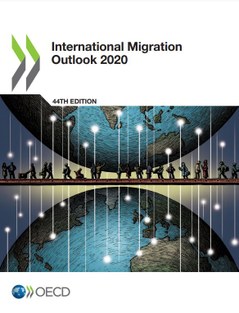Migration to the OECD nearly halved during Corona pandemic
As a result of the Corona pandemic, the number of migrants being granted visas and residence permits for an OECD country has fallen dramatically. During the first six months of 2020, the number fell by 46% compared to the same period last year, according to the OECD’s International Migration Outlook 2020.
The report was presented on 19 October by OECD’s Secretary-General Angel Gurria, who had also invited Ylva Johansson, the EU Commissioner responsible for migration issues, to comment on the report. She started by saying that the migration issue had for a long time been overly dramatised.
“We should stay more sober and then we need facts and figures. Migration is normal, it is nothing to be afraid of. It will always be there. But we need to manage it. Out of the three million people who were granted a visa or permission to stay in the EU in 2019, only 10% were refugees.”
Three important areas
Angel Gurria said the report highlighted three particularly important areas when it comes to understanding how the pandemic has influenced migration.
- The migrants have been on the front line during the pandemic. 1 in 4 medical doctors and 1 in 6 nurses are migrants. They have also worked in transport, warehouses, cleaning, food industry, security and IT.
- Migrants are facing worse consequences than the ordinary population. Earlier improvements have in part been wiped out. The unemployment rate has risen more for the immigrants. Almost 60% of the initial surge in unemployment were immigrants.
- Immigrants have been highly exposed to the pandemic, because of their employment, but also through housing and poverty. In countries like Denmark, Norway and Sweden immigrants have been twice as likely to test positive for covid-19.
Ylva Johansson commented:
”Talking about integration it should not be us and them. They were on the frontline during the pandemic and they will be an important part of recovering.”
Sweden chose a different approach to most OECD member states by not closing its borders. The OECD has looked at the number of visas and resident permits awarded in Denmark, Norway and Sweden in the first six months of this year, and compared to the same period last year the figures look like this:

In these index graphs, January 2019 = 100. So the graphs show the changes in resident permits from that level during the first six months of the year.
The scales differ somewhat, but the fall was biggest in Denmark where the number of permits grew during January and February before falling sharply to a quarter of January 2020 levels. By June the level was at 70% of January 2020 levels.
Norway did not see similar growth in January and February, but fell to the same low level as Denmark. By June, the level was nevertheless still around half of it had been at the beginning of the year.
Sweden’s graph is much more level, and the number of permits never fell below 75% of what it had been in January 2020.
Big fall during the second semester
Within the OECD, the fall was smaller in European member states than in countries like the USA, Canada and Australia.
Overall, in OECD countries, issuances of new visa/permits plummeted by 46% in the first semester of 2020 compared to the same period in 2019. The decline was even sharper when looking only at the second quarter of 2020: 72% lower than the same period in 2019.
On average, the drop was smaller in European OECD countries: a 35% decrease from the first semester 2019 to the same period in 2020 and a 59% decline comparing second quarter 2019 and 2020.
Even if migration flows are expected to bounce back as the economy reopens, there are strong signs that they will not reach previous levels for some time because of weaker labour demand, ongoing travel restrictions and alternatives to mobility linked, for example, to the widespread use of teleworking among high-skilled workers and remote learning by students.
Migration, on the other hand, will continue to have an important impact on origin countries. Remittances are expected to decline and employment opportunities to become scarcer.
Risk erasing progress
“Today, there is a risk that some of the progress in migration and integration outcomes may actually be erased by the pandemic and its economic fallout. The pandemic has created many public policy challenges and public opinion and policy attention may be focused more on other key domestic issues.
“Public spending for integration, which should be considered as a long-term investment, may become scarcer in some countries at a time when it needs to be reinforced in the face of the looming overall employment crisis,” writes the OECD’s Director for Employment, Labour and Social Affairs Stefano Scarpetta, in the report’s preface.

 Follow us on Facebook
Follow us on Facebook
